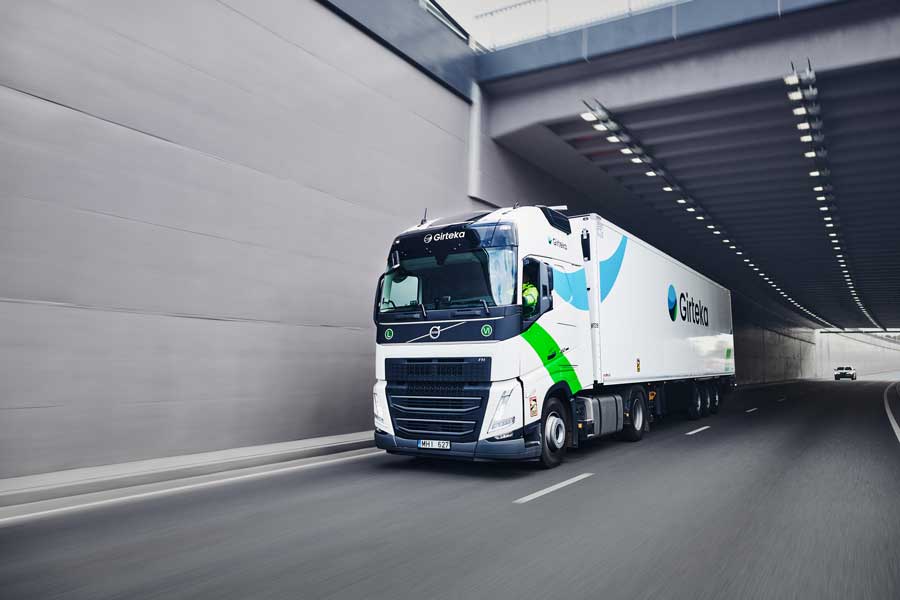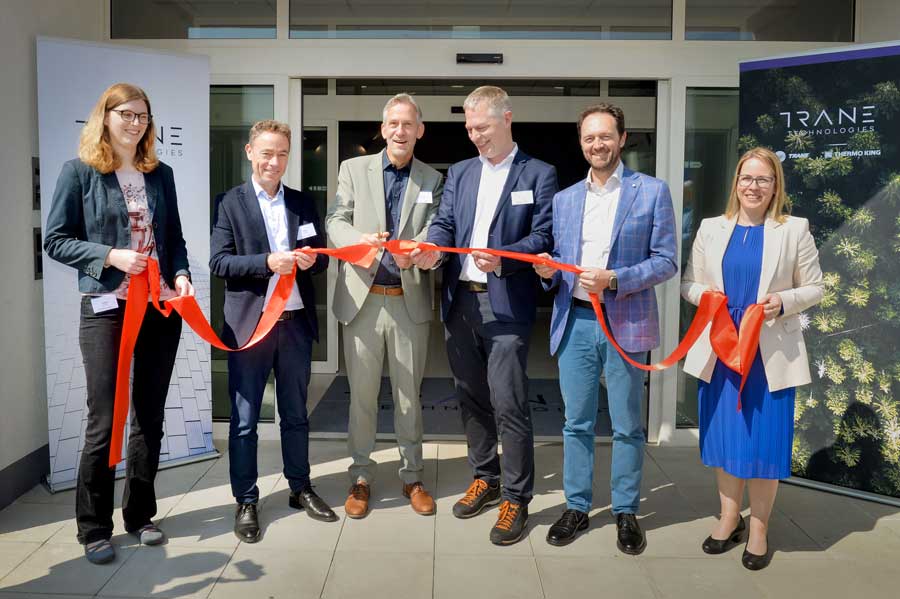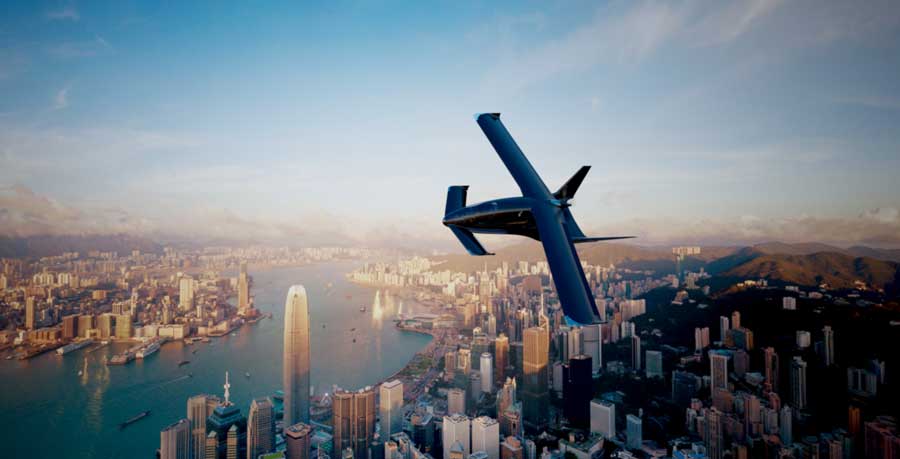By definition, construction equipment shapes the world in which we live, and helps build communities of the future. Now, consider a future in which these very machines deliver on their purpose even more sustainably, fueled by what we consider ‘waste’. What if these machines also produce 80% less emissions while improving the working environment of the operators? This was the ambitious goal the CASE Construction Equipment team set for itself. And it’s become more than a goal. The project designers and engineers have achieved it.
The project, code named ‘TETRA’, shows how professional construction operators could help spearhead the move away from fossil fuel powered vehicles towards renewable sources, by playing a fundamental role in the ‘closed loop’ virtuous cycle, which sees methane-powered wheel loaders help produce the fuel from waste products and renewable sources which ultimately powers them. And although this is a concept, CASE, a global construction brand of CNH Industrial N.V., is already working towards ultimate market viability.

This concept reimagines wheel loader design, and is a clear departure from anything seen in construction equipment to date. This methane-powered wheel loader concept reflects the increasing importance of alternative fuels, and demonstrates their viability in construction equipment, as well as the feasibility of creating and using fuel generated from waste products and renewable sources. Furthermore, CASE has proactively combined alternative fuels and advanced construction technology to create a modern, sustainable solution to the need for ‘future proof’ power, utilizing readily available and proven powertrain technology. ‘Practical Innovation’ is inherent in the brand’s product development philosophy, to innovate through the pragmatic use of advanced technology. As a result, this ‘concept’ is more than a mere exercise in design, and it has been tested in real world construction environments to demonstrate its feasibility.
Powerful methane engine technology from FPT Industrial
The new methane-powered wheel loader concept represents a significant technological advance for CASE, being the Brand’s first alternative fuel vehicle. This projects benefits from the existing research and development program of sister brand New Holland Agriculture, in off-road methane usage, with over seven years of experience and an extensive global testing program. The CASE concept uses an FPT Industrial methane engine which has been specifically developed for construction applications and delivers maximum power of 230hp – identical to the equivalent diesel powerplant. This is achieved with a 50% reduction in drive-by noise levels, which makes it ideal for municipal applications and when working in close proximity to offices, residential areas and people.

The engine features stoichiometric combustion technology, developed by FPT Industrial, and first introduced in 1995; it is applied across the entire natural gas engine portfolio as it enables comparative performance to diesel engines, while delivering ultra-low emissions and high efficiency.
The virtuous cycle: the benefits of biomethane
Biomethane is produced using a cyclical system that delivers CO2 neutral production. It particularly suits wheel loader applications, especially those employed in waste handling situations or on farms, as they handle the raw materials which are used to produce the biomethane which fuels them. This enables these businesses not only to be fuel sufficient, but also energy sufficient, as biomethane can also be burned to generate electricity to power buildings as well as to satisfy any heating requirements. In addition, it can be fed into the gas grid for domestic purposes, and can be used to create electricity to be fed into the national grid to power communities, creating a truly virtuous cycle.
Biomethane can be produced from a mixture of domestic organic waste, waste food from industrial food production, restaurants, canteens as well as from waste biomass products such as wood chippings, animal waste, and specifically-grown energy crops and waste plant matter. All of these inputs are fed into a biodigester. Here, in the absence of air, the contents are heated and begin to break down biologically as they are digested by bacteria, much like any compost heap. As this occurs, biogases are generated – including biomethane – in a two-stage fermentation process lasting around 60 days. These gasses are eventually refined to produce fuel-grade biomethane, a product which can then be used to power the wheel loader.

Known as digestate, the liquid and solid waste materials collected from the digester after gas production has ceased, have a high nutritional profile, and are used as fertilizer, being sold for domestic use in gardens or to agribusinesses.
In this way, waste handling facilities can produce their own CO2-neutral fuel, while also protecting themselves from fluctuating oil prices, as well as benefiting from significant machine running cost savings of between 10 to 30 percent over diesel. Furthermore, they can benefit from an additional revenue stream by selling biomethane to third parties to fuel their vehicles. The methane-powered wheel loader concept produces 95% less CO2 when running on biomethane, 90% less nitrogen dioxides and 99% lower particular matter than a diesel powered equivalent, delivering an 80% reduction in overall emissions.
For operations that do not have the resources to produce their own biomethane, the methane- powered wheel loader concept can be powered by ‘conventional’ network natural gas. This is of particular interest to waste handling facilities and to urban and suburban operations, which have ready access to the natural gas grid. These facilities, with a moderate investment, can install an on-site compression system, which extracts natural gas from the grid, and subsequently compresses it to fuel-grade pressure, providing instant and constant refueling. This infrastructure can be further leveraged by these businesses, as eventual gas powered trucks transporting goods to and from the sites could also be fueled using this technology, further enhancing the sustainable profile of the operation.

A full day’s autonomy
To make optimal use of space, the wheel loader’s fuel is stored within technologically advanced tanks within a sleek and integrated storage unit fitted at the rear and sides of the wheel loader. This configuration enables a full day of autonomy. The wheel loader is as easy to refuel as one powered conventionally by diesel, using a single nozzle, from ground level, and with comparable filling time.
Due to the reduction in polluting emissions arising from methane combustion, a simplified after treatment system is used, which features a maintenance-free single standard catalytic converter.
Proven expertise in natural gas powertrain technologies
CNH Industrial’s brands have a long history in developing and commercializing natural gas- powered vehicles, and they are the market leaders in this area. Since pioneering natural gas technology some 20 years ago, FPT Industrial, the powertrain brand of CNH Industrial, has produced more than 40,000 natural gas engines, running on both compressed natural gas (CNG) and liquefied natural gas (LNG). There are some 28,000 natural gas-powered vehicles from CNH Industrial’s truck and bus brands IVECO and IVECO BUS on the road today, making them the absolute European leaders in this segment. Capital cities as diverse as Astana, Baku, Madrid and Paris have chosen natural gas-powered IVECO BUS fleets to transport their citizens. Today, there are some 7,000 gas-powered IVECO BUS products on the world’s roads.

CNH Industrial and IVECO are working with world governments, such as those of Israel and Japan, and with European countries to develop alternative fuel and natural gas-based technologies and infrastructure. In addition, FPT Industrial is working on a range of hybrid and full-electric propulsion solutions, with some 1,700 IVECO and IVECO BUS vehicles powered by this technology produced to date. FPT Industrial is also looking to the future, and is pioneering the development of full-hydrogen powertrain systems.
‘ProjectTETRA’ methane-powered wheel loader – A name for the future
The ‘TETRA’ project name reflects the ambitious goal of the concept, yet one which is rooted in real world pragmatism – a hallmark of the CASE brand. Tetra, Greek for the number ‘four’, refers both to the four hydrogen atoms which combine with the single carbon atom to compose the chemical formula of methane ‘CH4’, as well as the tetrahedron shape of the methane molecule. The tetrahedron motif is mirrored in the futuristic graphics applied to the wheel loader’s rear ‘wings’.
Versatile construction excellence
The methane-powered wheel loader concept is able to complete the full range of tasks that a standard diesel-powered wheel loader would undertake. From efficient work in quarries, waste handling facilities, agricultural applications, and wood yards through to municipal applications, and those which require extensive transport, this concept delivers outstanding performance in a productive and sustainable package. Furthermore, this concept is compatible with the complete range of buckets, and was fitted with high tip and quarry versions from Leonardi Benne during the initial testing activities.

Innovative, productivity-focused design
CNH Industrial’s international design team have reimagined wheel loader styling, starting from a blank sheet to create a viable vision for the future of wheel loader design. Iconic CASE styling cues provided inspiration: CASE’s ‘Old Abe’ eagle, whose majestic sweeping wings find expression in the integrated cab wings, and the essence of its commanding head and beak has been distilled in the rear engine cover. Key design features accentuate the overall styling and include a forward cab stance, high visibility 360° glazing, 16% more than a standard wheel loader, a high visibility roof panel, which provides the operator with an unfettered view of the bucket throughout the entire loading arc, and an industry-first sliding door. The dynamic air intakes in the engine cover and downward mounted exhaust provide an ‘aggressive’ stance. Overall design unity is achieved through a carefully conceived design language which sees the loader arms, fenders, cab, rear wings, engine cover and counterweight melded into a unified whole.
A complete LED lighting package features signature lighting, with lights integrated into the loader arms, front fenders, front and rear mounted roof work lights, aggressive rear lights integrated into the rear fenders and engine cover, and stop and hazard lights nestling in the rear counterweight, all combine to offer unsurpassed levels of visibility. Operators can either select auto mode, in which all working lights are automatically activated in low ambient light conditions, ideal when working at night or when moving between dimly lit sheds and exterior environments, or manual operation, in which they select the required lights. Ambient power- tan cab lighting can also be selected.
A range of technologically advanced materials have been used to improve the operator environment, to enhance comfort, to reduce fatigue and to facilitate cleaning. The cab itself has been trimmed in an ultra-robust cream colored technical cloth, which affords a feeling of space and can be easily wiped down for swift cleaning. This is paired with a chestnut color leather on key touch points for added warmth and serenity. The durable stone floor reinforces the objective to deliver practical design, and the feature aluminum kick plate and floor inlay elevate the interior. This is combined with soft touch aluminum grab handles and carbon fiber fenders to complete the modern look.

A custom metallic fleck CASE ‘power-tan’ paint finish was commissioned for the methane- powered wheel loader concept, and subtly enhances the machines distinctive lines, whilst cementing its link to the CASE family. The powdered anthracite finish on the metal exterior elements offers outstanding weather and dirt proof properties, and is a striking foil to the luxuriant paint finish. Traditional CASE elements such as the new ‘Power-Abe’ eagle emblem have been integrated into the engine cover, loader arm supports and the CASE name has been inlayed into the top step and loader arms.
Ergonomic, intuitive and connected operation
The minimalist design of the cab offers intuitive, clutter-free operation, with instant access to all key controls via ergonomic joysticks and an integrated, armrest-mounted, color touchscreen monitor.
The armrest mounted monitor is the operating hub, and can be used to control the following functions:
· Face scan to activate start-up sequence.
· Bucket load-fill assist screen which displays target load, current bucket load, via loader arm mounted sensors, and remaining load.
· Jobsite map, which tracks incoming trucks, indicates the fastest route to the selected work area and displays general site information.
· Weather screens showing real-time weather reports.
· Lighting parameters, Bluetooth telephone, heating and ventilation and music controls.
· Access to secondary machine parameters, machine settings and additional submenus.
All aforementioned settings can be directly modified on the touchscreen. Upon request, the screen can be swiped from the armrest monitor the lower right-hand A-Pillar screen. When no longer required, the operator simply selects another screen from the armrest monitor to swipe and replace.
The inclined A-Pillar screens have been mounted to perfectly align with the cab’s pillars and provide at-a-glance key information.
·The top right and left screens display the front and rear camera feed. Cab-mounted cameras replace traditional wing mirrors, and the display is automatically linked to the direction of travel, changing in sync with machine shuttling.
·The central right A-Pillar screen features all key machine operating parameters including machine speed, engine speed, fuel level, engine and oil temperature, selected gear, engine hours and time.
· The lower right screen can be customized, and enables operators to select, using the armrest color touchscreen, the desired view.

Voice control functionality has been integrated into the cab, through the use of ‘home hub’ technology – a device integrated into the cab roof, which uses Internet of Things technology to action verbal commands. Operators can control cab temperature, select music, make and receive calls and dictate messages using this technology.
Remote machine priming occurs through the use of a retina scan on a connected mobile telephone. This enables operators to remotely initiate cab warming, cooling or defrost functions.
The new cosseting seat automatically extends and pivots to facilitate entry upon door opening, returning to the operating position immediately after the operator is seated, an industry first. This functionality can be manually overridden, should the operator so desire. Produced in a two-tone finish, the leather accents add a touch of automotive luxury and are complemented by a robust heavy duty fabric. The entire seat features integrated heating and cooling – designed to keep the operator cool in hot weather and insulate them in cooler periods. Active, weight compensated suspension and fully-adjustable lumbar support enhance comfort for all operators.
An advanced full-cab heating and cooling package has been designed to ensure full body comfort. A range of vents have been precision positioned in the headliner, and in an ideal arc around the operator to ensure optimal full body comfort.
The fundamental role connected construction plays has been placed at the heart of this concept. The full range of telematics solutions has been integrated, connecting this concept to a control room, which is manned 24 hours a day, 365 days a year, and ensures optimal machine operation at all times. Fleet managers can communicate directly with the concept through on-board audio and text messaging, enabling the operator to fine tune machine parameters, such as tire pressure to enhance operating efficiency and productivity, from the comfort of the cab.
Safety first design
Jobsite safety is a top priority for today’s construction equipment professionals, and ensuring that only fully-qualified operators have access to machines is essential. That is why biometric facial recognition technology has been integrated into the access and start-up sequence. A door-mounted facial scanning sensor, scans the operators face, upon approach, to activate door opening. Once the operator is in the cab, a second scan is conducted from the armrest monitor for final confirmation and to initiate the start-up sequence.
Elements of CNH Industrial’s autonomous vehicle development program have been incorporated into the machine’s design. Advanced obstacle detection technology, which automatically brings the machine to a halt and informs the operator if an obstacle comes into range, is available to further enhance jobsite safety.

Advanced tire technology
The concept wheel loader is compatible with the full range of tire solutions to ensure efficient working in all construction environments. In order to spotlight the key role tire technology plays in machine productivity, the CNH Industrial and MICHELIN design teams worked in partnership to develop a vision for a future airless tire. This cutting edge design foresees a
fusion of the tire/wheel combination and features inbuilt suspension. Furthermore, thanks to its pure rubber and patented composite material construction, it has been designed to withstand the extreme conditions present in construction environments, and could be considered indestructible.
The tire’s honeycomb spoke design is lightweight yet robust and thanks to its bespoke asymmetric tread pattern traction, motricity and grip are significantly improved. The tripod blocks on the inner tread section enhance overall operational stability, as well as assisting turning performance. The airless tires reduce overall machine weight and its large footprint delivers low contact pressure. The striking edge bumpers improve overall tire robustness as well as enhancing protection for extended life. Advanced connectivity is foreseen with integrated sensors providing a stream of real-time data to both the operator and the control room – including a tire wear sensor. When active, the integrated sidewall lights are illuminated, which also function as an additional safety feature.
Combining a modern, ergonomic and intuitive operator environment, with sustainable, proven, readily available powertrain technology, advanced digital and autonomous elements, and MICHELIN tire expertise, the CASE methane-powered wheel loader concept ‘ProjectTETRA’, represents a viable future for efficient, productive and sustainable construction.










